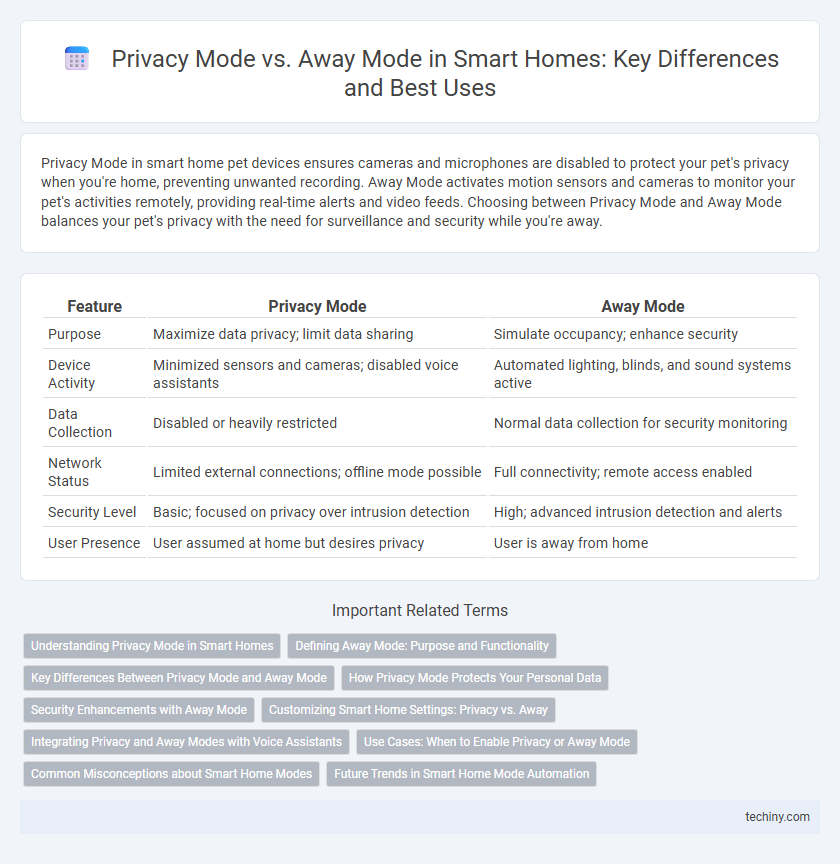Privacy Mode in smart home pet devices ensures cameras and microphones are disabled to protect your pet's privacy when you're home, preventing unwanted recording. Away Mode activates motion sensors and cameras to monitor your pet's activities remotely, providing real-time alerts and video feeds. Choosing between Privacy Mode and Away Mode balances your pet's privacy with the need for surveillance and security while you're away.
Table of Comparison
| Feature | Privacy Mode | Away Mode |
|---|---|---|
| Purpose | Maximize data privacy; limit data sharing | Simulate occupancy; enhance security |
| Device Activity | Minimized sensors and cameras; disabled voice assistants | Automated lighting, blinds, and sound systems active |
| Data Collection | Disabled or heavily restricted | Normal data collection for security monitoring |
| Network Status | Limited external connections; offline mode possible | Full connectivity; remote access enabled |
| Security Level | Basic; focused on privacy over intrusion detection | High; advanced intrusion detection and alerts |
| User Presence | User assumed at home but desires privacy | User is away from home |
Understanding Privacy Mode in Smart Homes
Privacy Mode in smart homes disables all non-essential data collection and limits device interactions to preserve user confidentiality. This setting encrypts communications and blocks external access, ensuring that cameras, microphones, and sensors remain inactive when desired. Unlike Away Mode, which emphasizes energy savings and security while the homeowner is absent, Privacy Mode centers on minimizing data exposure even when occupants are present.
Defining Away Mode: Purpose and Functionality
Away Mode in smart home systems enhances security by simulating occupancy through automated lighting, sounds, and appliance control when residents are absent. It functions to deter potential intruders by creating the illusion of presence, leveraging programmed schedules and sensor integration. This mode prioritizes privacy by limiting notifications and external access, ensuring homeowner data remains secure during prolonged absences.
Key Differences Between Privacy Mode and Away Mode
Privacy Mode in smart homes disables sensors and cameras to protect personal data while occupants are present, ensuring no recordings or monitoring occur. Away Mode activates full security protocols, including motion detection, video surveillance, and alert notifications when the house is unoccupied. Key differences lie in their operation states: Privacy Mode is designed for occupant presence with minimal data capture, whereas Away Mode focuses on protecting the home from external threats during absence.
How Privacy Mode Protects Your Personal Data
Privacy Mode in smart home systems encrypts personal data locally, preventing unauthorized access or sharing with third-party services. It disables remote monitoring and voice assistant activity, ensuring users' conversations and behaviors remain confidential. This mode strictly limits data transmission, reducing exposure to cyber threats and safeguarding sensitive information within the home network.
Security Enhancements with Away Mode
Away Mode in smart home systems significantly enhances security by simulating occupancy through automated lighting, sound, and appliance controls, deterring potential intruders effectively. It integrates with motion sensors and surveillance cameras to trigger alerts and record suspicious activities, ensuring continuous monitoring in the homeowner's absence. Privacy Mode, while focusing on limiting data sharing and user tracking, does not provide the proactive security measures that Away Mode delivers during extended absences.
Customizing Smart Home Settings: Privacy vs. Away
Privacy Mode in smart homes prioritizes data security by limiting device access and disabling cameras and microphones to protect personal information. Away Mode enhances security by activating surveillance, motion sensors, and automated lighting to simulate occupancy and deter intruders. Customizing settings between Privacy and Away Modes allows homeowners to balance personal privacy with home protection based on occupancy status.
Integrating Privacy and Away Modes with Voice Assistants
Integrating Privacy Mode and Away Mode with voice assistants enhances smart home security by allowing users to control data sharing and device activity remotely through voice commands. Privacy Mode disables microphones and cameras to protect personal information, while Away Mode simulates occupancy by managing lights and appliances. This seamless integration ensures users maintain control over their privacy and home automation even when not physically present.
Use Cases: When to Enable Privacy or Away Mode
Privacy Mode in smart homes is ideal when occupants are present but require enhanced data protection and limited device activity, such as during sensitive meetings or personal time. Away Mode activates automatically or manually when no one is home, optimizing security settings like alarm systems and energy-saving configurations. Selecting the appropriate mode improves both privacy controls and energy efficiency tailored to occupancy status.
Common Misconceptions about Smart Home Modes
Privacy Mode in smart homes primarily disables data sharing and limits device access to protect user information, while Away Mode focuses on security by activating alarms and motion sensors during absence. A common misconception is that Away Mode fully ensures privacy, but it mainly enhances security without restricting data collection or communication between devices. Users should understand that Privacy Mode addresses data privacy concerns, whereas Away Mode targets home security, making both modes complementary but functionally distinct.
Future Trends in Smart Home Mode Automation
Future trends in smart home mode automation emphasize enhanced Privacy Mode features with AI-driven behavior prediction and adaptive security protocols to protect personal data in real time. Away Mode advancements integrate geofencing and IoT sensor fusion to create intelligent presence simulation, optimizing energy efficiency and deterring intruders. Emerging technologies prioritize seamless mode transitions using machine learning algorithms for context-aware automation, ensuring user privacy without compromising home functionality.
Privacy Mode vs Away Mode Infographic

 techiny.com
techiny.com